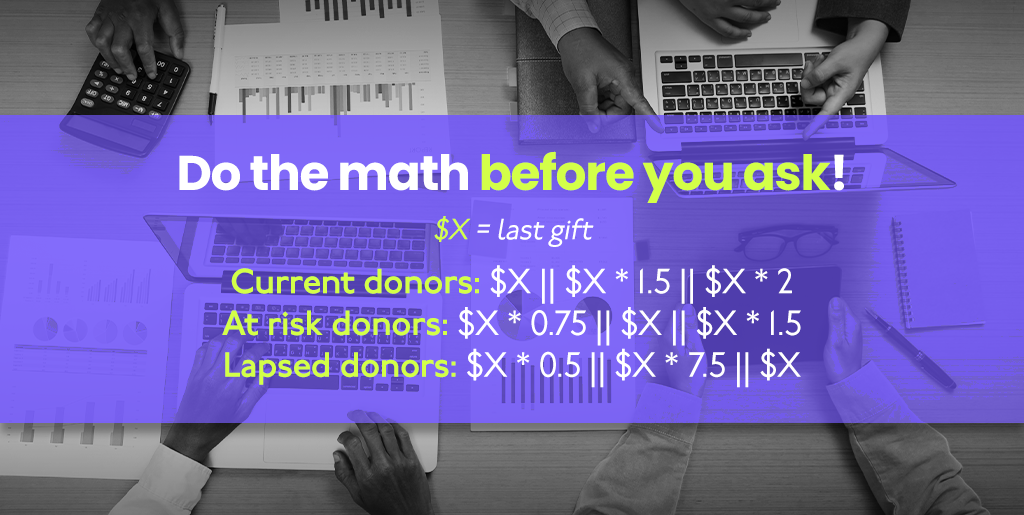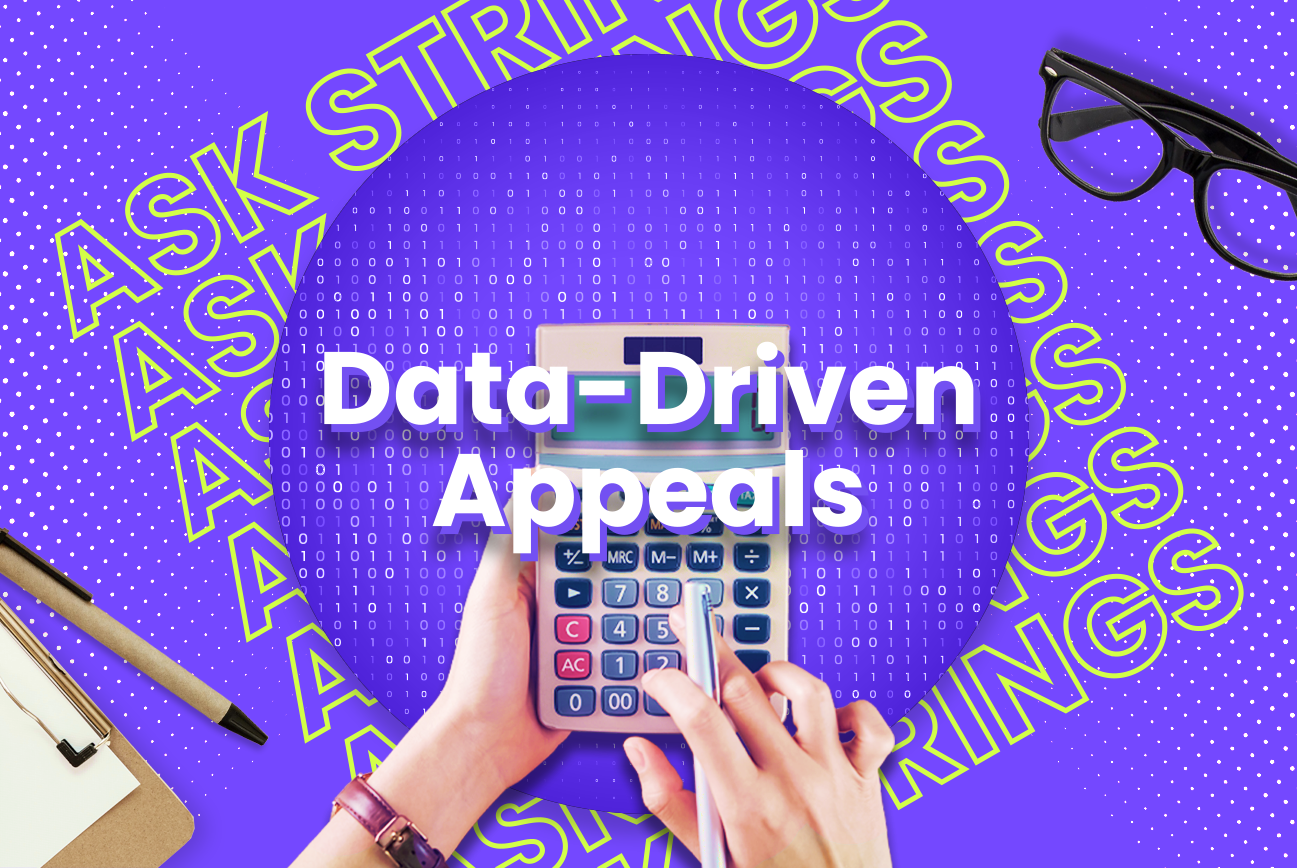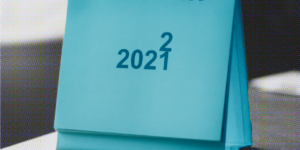If you’ve read our blog before, you know a lot of our advice relies on your nonprofit’s ability to collect, store, and utilize strong data. It’s true, whether you are building targeted audiences, creating more personal communications, or developing data-driven ask strings!
You can spend a lot of time and effort using data to make your outreach more relevant for your audience. But, if you don’t put the same effort into to your ask string, you could still fail to reach your fundraising goals.
Sure, there are some easy ways to adjust your asks to guide donors towards the best choice. But the most effective asks are rooted in an analytical approach.
Ask yourself these important questions before we dive in:
- Where do you draw the line between mid-level and major donors?
- Are repeat donors making larger gifts over time?
- What is the lowest ask you are willing to make?
Every organization will have different answers. And you may even decide to adjust your approach for each appeal! But it’s critical to define these parameters before building out data-driven ask strings regardless.
These are some of the ways we partner with nonprofits to develop more targeted ask strings based on how they answer these questions.
For regular donors.
Let’s start with the bulk of your donor base. Now that you’ve defined where you draw the line between mid-level and major donors, you need to determine how to make an appropriate ask for the former.
Why? Because if your lowest major gift is $2,000, you will have mid-level donors who give $1,000. And you shouldn’t present the same ask string to a $100 donor and someone whose last gift was $500, $1,000, or $1,500!
You also want to present a safe donor choice.
You’ll see we recommend no more than three targeted asks in our examples. But we also include a fourth option of “Other: $_____” so the recipient can write in their desired gift. But there are many ways to create personalized ask strings.
So, try using one of the following simple strategies in your next appeal!

1. Mathematical formula.
This is the most common and straightforward method of the three and a great way for nonprofits with limited data to get started. The only thing you need to know is the value of a donor’s most recent gift, or their average gift value during a fiscal year if you send multiple appeals in a year.
Our standard is to use the last gift as the low-end ask, and double that number as the highest of the three. The center target ask falls right in between, subtly encouraging a donor to increase their gift by 50 percent!
As always, your data can help you go further.
Use the suggestion above for your current donors, and a less aggressive ask string for donors whose last gift was some time ago.
So, if a current donor’s last gift was $100, you would present them with an ask string of $100, $150, $200. But an “at risk” donor whose last gift was also $100 would see an ask string of $75, $100, $150, while a lapsed donor would receive $50, $75, $100.
You should round a donor’s last gift to an even number to avoid unusual ask amounts like $83.
And don’t forget to remind donors of their last gift amount and the impact they made on your mission! This shows them you pay attention to your supporters, and it can influence the value of their donation.
As always, spot check your list, especially for those recipients who are extremely important to the organization or who tend to complain. Make sure you are comfortable with their asks and don’t be afraid to adjust them as necessary.
2. Pre-set formulas.
This is where the more labor-intensive work gets involved. You will need to use your audience’s giving history to create general giving levels in order to use pre-set formulas in your asks.
So, your asks will still be based on how much a donor previously gave. But this approach will use those giving tiers to determine the right ask, rather than a formula.
For example, if a donor’s gift was $350 last year, their pre-determined ask might be $250, $350, $500 since they fall in the $250 – $499 giving level.
But be careful! Using this approach means some donors may receive a base level ask lower than their last gift amount. And considering where to cut each level and grouping donors accordingly is more labor intensive than using a standardized formula.
3. Individual targets.
Coming up with a unique ask string for each donor is by far the most time consuming of these three approaches to variable asks. You will have to dig through every record in your database and use giving history and your intuition to determine the best ask for each donor.
While we know that every nonprofit would want to put this level of care into their outreach for every donor, this approach might only be practical for nonprofits and local organizations with a small donor base.

What about major donors?
Your data-driven ask strings need to feel much more personal for major donors.
But here’s the good news: You’re probably already personalizing your ask in your one-on-one conversations!
But this means using a mathematical formula or level-based ask may not reflect what you’ve previously discussed with these key supporters. So, we recommend a different strategy for this group. And it involves abandoning the three-string ask all together.
How you approach this is dependent on your definition of a major donor and how you determine leadership tiers. You may even decide to use some of these approaches for mid-level donors.
Now, we know what you are thinking.
“If we don’t include specific giving options, how will they know what to give?”
Well, you can still remind donors of their last gift amount on your reply card and appeal letter. This will serve as a guideline for what they are expected to give.
However, the way you present this information depends on the action you want a major donor to take. Are you trying to increase gifts from current major donors, or are you content with maintaining them at the level they’re at? The answer will guide your approach and help determine how aggressive to be.
READ MORE: The secret of building relationships with major donors.
Passive: Blank gift/no specific ask.
This option gives the donor the most freedom to write in a gift amount they are comfortable with. Of course, the reply card will provide a glimpse of their past giving.
This strategy usually results in a gift that is around the same amount as their last donation. But this approach can backfire and result in a lower gift if you do not remind them of their past giving and impact!
Aggressive: Renew/increase.
Keeping it simple and providing two options, renew or increase, can guide major and mid-level donors towards the desired result. Ask them to fill in one of the following options.
“Please renew my gift of $XXXX”
“I want to increase my gift to: $_________”
Aggressive: Leadership level asks.
Our third option focuses on encouraging donors to join your leadership ranks, rather than using a specific dollar amount.
Only the highest-level donors will have a blank ask string for this approach. This will usually be accompanied by some graphic of a leadership table that show the dollar ranges for each level.
“Please consider joining our Platinum Level supporters by increasing your gift.”

For non-donors and small gift donors.
Whether you’re reaching out to inactive former donors or sending an acquisition appeal, you need a separate strategy for data-driven ask strings with non-donors.
After all, you don’t have recent past giving data to work with. So, the key here is finding the right minimum ask.
Many organizations find success with a $25, $50, $100 ask string for non-donors. But like everything else, it really depends on what works best for your organization. Don’t be afraid to A/B test two versions of ask strings on your next appeal.
And use what you already know about your donors to determine the right minimum ask.
For example, if you have a younger donor base with less earning potential, you may want to start smaller.
And you might discover you need to use different minimum asks for different constituency groups. For example, an independent school might use a lower ask of $15, $25, $50 for young alumni and a higher ask string of $100, $250, $500 for current parents.
We also recommend using your minimum ask strings for current donors whose last gift was less than your first ask. It’s important for every donor to receive an ask that they feel comfortable with. But you don’t want to build ask strings based on prior gifts of $1.
READ MORE: How to maximize the value of small dollar donations.

Find out what works.
You need to build processes and rules for data-driven ask strings that work for your organization. As you know, no two nonprofits are the same. You’re reaching out to different audiences, with a different message, about a different mission.
Successful appeals show the recipient that you really know them as an individual. And data-driven ask strings serve as an extension of that principle. But as we discussed, making a personal and powerful ask requires a deep analytical approach.
So, develop a plan, test it out, and track your results!
Then, use what you learn about what works best for your audience segments the next time you launch an appeal! Without strong data, it is impossible to know if the changes you are making are having a positive impact on your fundraising.


![[amplifi] - eBook pop ups and banners _Ask Strings (blog) FREE eBOOK: Ask strings and the science of securing support.](https://amplifinp.com/wp-content/uploads/2022/03/amplifi-eBook-pop-ups-and-banners-_Ask-Strings-blog.png)





